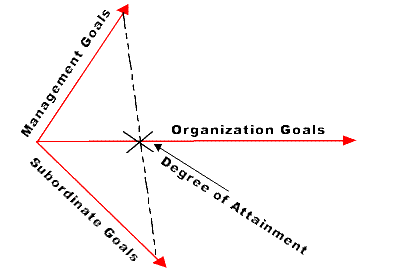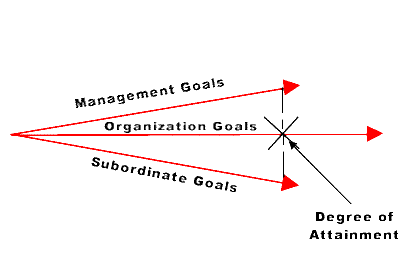
The extent that individuals and groups perceive their own goals as being satisfied by the accomplishment of organizational goals is the degree of integration of goals. When organizational goals are shared by all, the term goal congruence can be used.
To illustrate this concept, we can divide an organization into two groups, management and subordinates. The respective goals of these two groups and the resultant attainment of the goals of the organization to which they belong are illustrated in Figure 1

Figure 1: Direction of goals - Moderate Goal Congruence
In this instance, the goals of management are somewhat compatible with the goals of the organization but are not exactly the same. On the other hand, the goals of the subordinates are almost at odds with those of the organization.
The result of the interaction between the goals of management and the goals of subordinates is a compromise, and actual performance is a combination of both. It is at this approximate point that the degree of attainment of the goals of the organization can be pictured.
This situation can be much worse when there is little accomplishment of organizational goals, as illustrated in Figure 2.

Figure 2: Little organizational accomplishment
In this situation, there seems to be a general disregard for the welfare of the organization. Both managers and workers see their own goals conflicting with those of the organization.
Consequently, both morale and performance will tend to be low and organizational accomplishment will be negligible. In some cases, the organizational goals can be so opposed that no positive progress is obtained.
The result often is substantial losses, or draining off of assets (see Figure 3). In fact, organizations are going out of business every day for these very reasons.

Figure 3: No positive organizational accomplishment
The hope in an organization is to create a climate in which one of two things occurs. The individuals in the organization (both managers and subordinates) either perceive their goals as being the same as the goals of the organization or, although different, see their own goals being satisfied as a direct result of working for the goals of the organization.
Consequently, the closer we can get the individual's goals and objectives to the organization's goals, the greater will be the organizational performance, as illustrated in Figure 4.

Figure 4: Successful congruence, organization, management and subordinate goals. High achievement environment
One of the ways in which effective leaders bridge the gap between the individual's and the organization's goals is by creating a loyalty to themselves among their followers. They do this by being an influential spokesperson for followers with higher management. These leaders have no difficulty in communicating organizational goals to followers and these people do not find it difficult to associate the acceptance of these goals with accomplishment of their own need satisfaction.